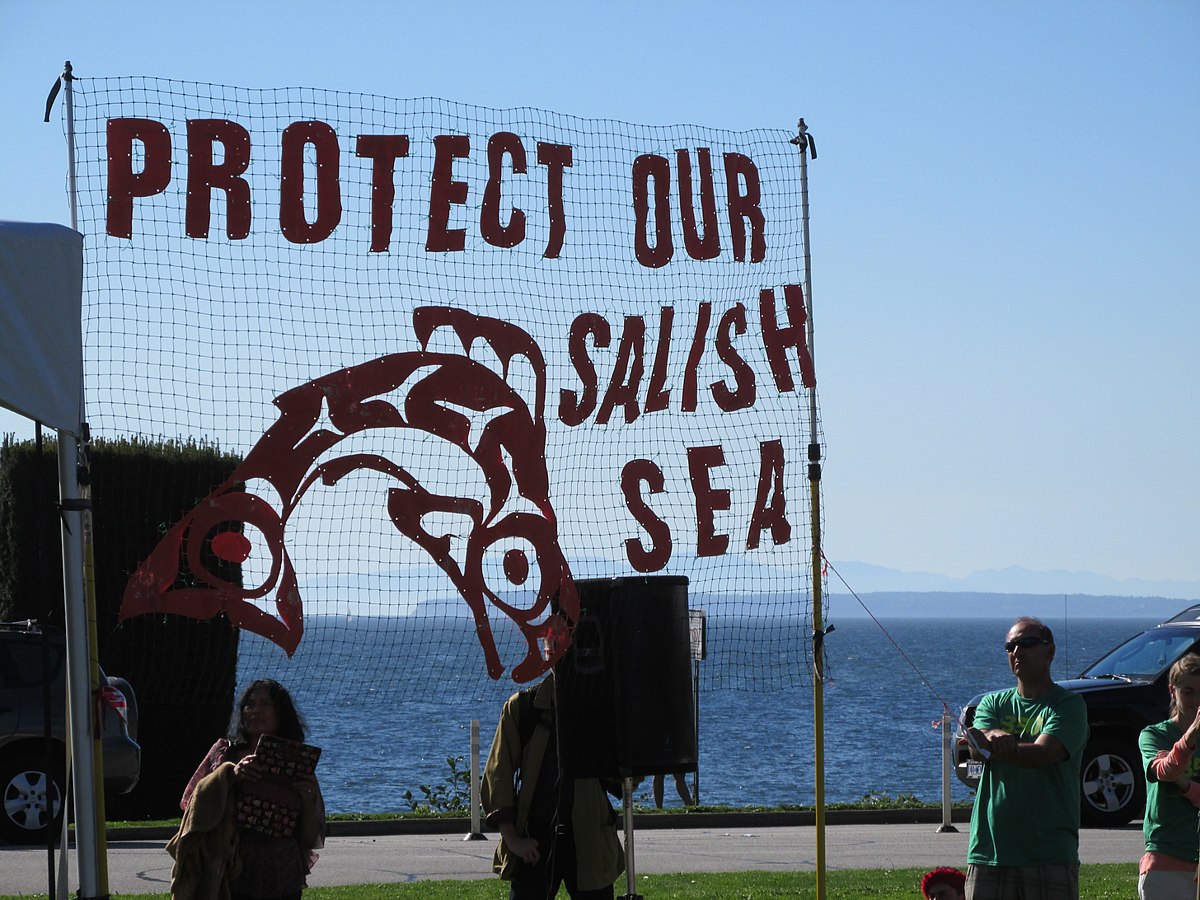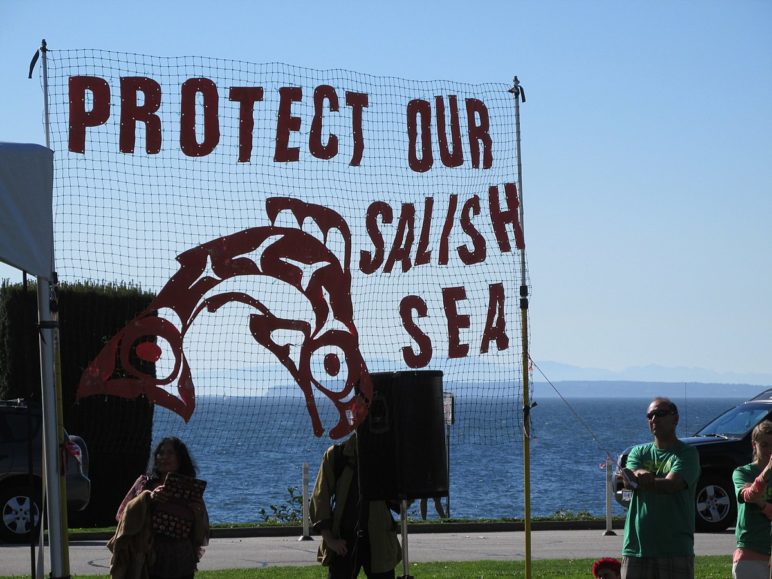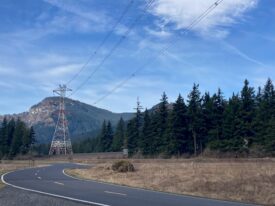There’s much ado about Canada’s insistence on building the Trans Mountain oil pipeline, a colossal delivery mechanism to bring tar sands fuel from Alberta. The project is unusually large but it’s of a piece with the oil industry’s decades of relentless expansion on the shores of the Salish Sea. Despite the industry’s assurances—to say nothing of the thousands of pages of environmental review, activism, and legal challenges—the price tag for a serious oil spill is anyone’s guess.
That’s right: no one knows what an oil spill could cost us.
It’s a colossal oversight for a region that says it values the fragile waters of its inland sea. Puget Sound is peppered with refineries, shipping terminals, pipelines, and oil train depots, and it is therefore exposed to constant threat of oil contamination. A tar sands spill, for example, could be devastating for the region’s ecology, but no one seems to know what the taxpayer bill might be.
A tar sands spill, for example, could be devastating for the region’s ecology, but no one seems to know what the taxpayer bill might be.
We’ve combed the literature—scientific, governmental, and back-of-the-napkin—for any credible estimate of oil spill costs in the Salish Sea, but we could find vanishingly little. Only a handful of published cost estimates might have any relevance to the growing risk the region faces, and even these are spotty at best.
The University of British Columbia Fisheries Center has issued two studies. A 2015 report made estimates for a hypothetical oil spill of about 100,000 barrels—about a quarter of the volume of a typical tanker—at the First Narrows in Vancouver. Professor Ussif Rashid Sumaila and a pair of graduate students calculated that a spill of that size at the site would lead to economic losses in the range of $215 million to $1.23 billion and threaten 1,900 to 12,000 person-years of employment.
An earlier 2012 research report by Hotte and Sumaila assessed the potential economic impacts on ocean-based industries in British Columbia’s North Coast region from a tanker spill. (That scenario was more likely before Prime Minister Justin Trudeau formally rejected the Enbridge Northern Gateway oil pipeline proposal in late 2016.) They concluded that a high-impact spill could cost the sparsely populated areas much as $308 million in economic output, and 4,379 person-years of employment. But the authors concluded that spill response, clean-up, and litigation could run a much bigger tab, perhaps as much as $9.6 billion.
On its website, the Washington Department of Ecology maintains that a “significant oil spill” could cost the state $10.8 billion and “adversely affect” 165,000 jobs, apparently on the strength of studies done in 2004. The agency uses the numbers in multiple locations but there is no clear basis for this estimate, nor any coherent explanation of what it means.
Our sleuthing revealed a joint publication by Ecology and Puget Sound Partnership circa 2011, which contained the same estimates and referred to a 2004 study by a consulting firm called Applied Science Associates. We were not able to locate that study, but we did find an apparently related paper presented at the 2005 International Oil Spill conference, whose co-authors included several with the firm. It analyzed a hypothetical oil spill in coastal waters near Washington’s Cape Flattery, concluding that average Natural Resource Damage Assessment (NRDA) costs could reach $1.2 billion. (An NRDA is an established legal process that government agencies use to determine the impacts of spills on natural resources.) The same 2005 conference paper reported that “results of these and other scenarios” are available in an earlier 26-volume report done by many of the same authors that reportedly was submitted to the Department of Ecology in 2004. We suppose that this full report explains the $10.8 billion and 165,000 jobs estimate, but its location—and its contents—still elude us. In any case, it seems not available to members of the public.
Despite its murky origins, Ecology’s $10.8 billion estimate does seem plausible. Big oil spills can easily cost hundreds of millions—even billions—of dollars, both by running up huge cleanup tabs and by scuppering local economies. Consider that a 2015 spill on a beach near Santa Barbara cost $335 million, an oil pipeline that ruptured into a Michigan creek in 2013 ran more than $1.4 billion, and infamous 2010 Deepwater Horizon spill in the Gulf of Mexico cost a staggering $145 billion.
The Salish Sea has so far been spared a catastrophe, but the Northwest is no stranger to oil spills and the danger of a big spill is local waters is very real. In fact, the most detailed risk analyses show that the danger is growing—by a lot. Until we’ve seen the price tag for an oil spill, it would seem exceedingly unwise to continue approving new oil industry expansions. It’s not only the region’s iconic wildlife at risk, it’s our pocketbooks.
Ahren Stroming contributed research to this article.












Earl Richards
No tar sands tankers for the Salish Sea. The waterways of the Gulf/San Juan Islands are not suited to be international shipping lanes.
Stephen A. Verchinski
It’s the Cascadian quake that will be the unprecedented catastrophe. March’s Point alone will cause an ecosystems collapse with oil on Padilla Bay, the tsunami wash over into prime ag lands. Plus, the refineries never fully cleaned up the Superfund site there according to a hydrogeologist who did the cleanup coverup.
Stephen A. Verchinski
No but Trudeau is looking at two sections of the Trans Mountain to go there.
Jay Taber
The cost is immeasurable, as we know from the BP Deepwater Horizon scandal.
Katz
Why are we worrying about the cost or effects of an oil spill? Tesoro in an EFSEC hearing said that an oil spill is an economic benefit. You know, it would boost the local economy and put people to work. The higher the cost, the better the benefit. An oil spill is good for the fish. If there was a spill, the fishermen would just fish somewhere else. So, after about ten comments about the benefits of an oil spill, bring it on. Humans will profit from an oil disaster, it will only take approximately 20 years or so to minimize the effects to the aquatic food chain.
We need to stop talking about polluting the Salish Sea. Do something constructive like stop building new infrastructure, stop the expansion of existing industry, reduce shipping, and reverse the effects of our human footprints. Time is our enemy.
Steve Erickson
I understand the theory that calling out the negative economic impacts of whatever the proposed “development” is may convince those focused on so-called economic development that the particular “development” at issue is actually economically counter productive. But this approach rarely works at changing these narrow minds. Underlying the development = good worldview is a deeply embedded article of faith. This holds that “doing something” is inherently better than not “doing something.” Action is always better than inaction. Hence, pining down the astronomical economic cost that a large oil spill in the Salsh Sea would have may help win the hearts and minds of most people, but it is unlikely to move the boomers and boosters.
Joy Hughes
The cost couldn’t be measured in dollars, as the loss would be irreparable.